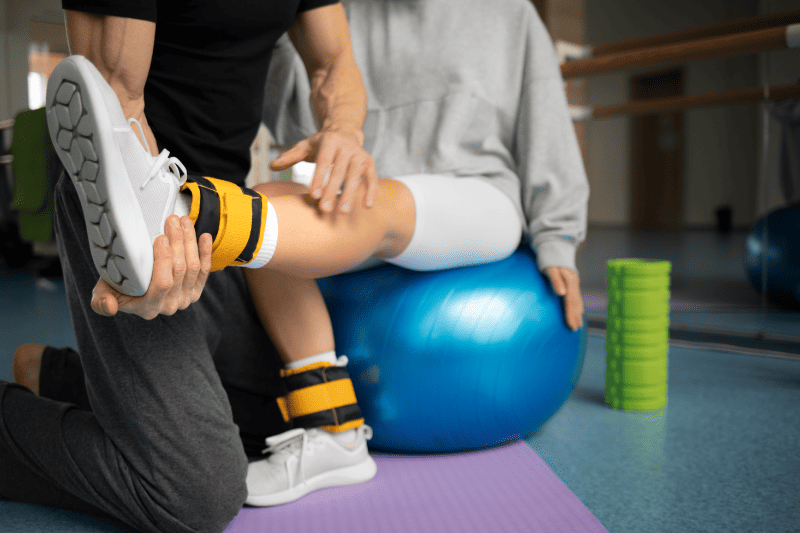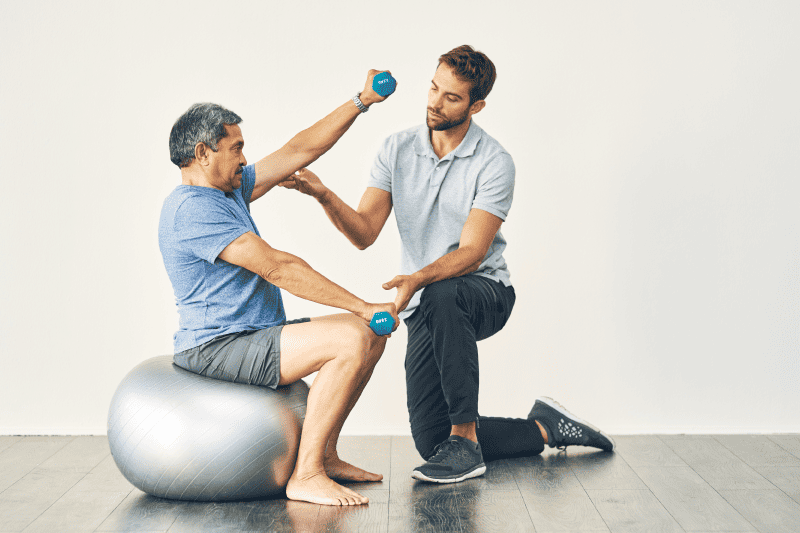Injuries are very common in sports and can range from minor sprains as well as strains to more serious conditions like fractures and torn ligaments. While it may or may not be severe, it is important that one undergoes a rehabilitation journey for a full recovery. Also, it helps in preventing future injuries. In this post, we will talk about physiotherapy for sports injuries in depth.
Take control of your sports injury recovery today – Contact us for personalized physiotherapy!
Book AppointmentA] Understanding Sports Injuries
Sports injuries are physical injuries experienced while participating in athletic activity. Sprains (ligament overstretching), strains (muscle or tendon injuries), fractures, and dislocations are common. Injuries related to overuse happen because of repetitive stress on a physical part, which is frequently caused by excessive training without adequate recovery. Traumatic injuries, on the other hand, occur unexpectedly as a result of crashes or falls.
These injuries can happen when athletes perform motions incorrectly, stressing muscles or joints. Poor warm-up, protection gear, and external circumstances such as slick surfaces – all contribute equally to sports injuries.
Sports injury prevention entails correct training, conditioning, technique, and suitable safety equipment to keep athletes in the best possible shape while minimising the chance of harm. Some of the most common sports injuries include ankle sprain, bruises, concussion, cuts and abrasions, fractures, dental damage, groyne strain, hamstring strain, etc.
B] The Role of Physiotherapy
Rehabilitation can come in many forms, and the best one is physiotherapy. With the help of a Physiotherapist in Mumbai, athletes can get on the track to a speedy recovery, be it any sport, cricket or football – the role of a physiotherapist cannot be undermined.
As we delve deep into physiotherapy, it is important for us to understand what exactly it is. Physiotherapy uses physical techniques that help reduce pain and stiffness, improve muscle movement, quicken healing, and increase quality of life.
On a broader note, physiotherapy includes exercises, stretches, massage, and other manual therapies. Some form of techniques we have already encountered at some point in our life. For example, if you go for an early morning walk or to the gym, you will see people doing some subtle form of stretching and exercises – all these forms are part of physiotherapy.
Another important part of physiotherapy is the emphasis on exercises that help to strengthen the affected area, thus preventing complications in the future. Exercises that increase flexibility, balance, and proprioception (awareness of body position and movement) can all be included. It increases the overall strength and stability of the damaged area while lowering the chance of re-injury.
The following are the most crucial phases of rehabilitation.
C] 3 Key Phases Of Rehabilitation
1. Acute Stage
At the time when the soft tissue injury has happened, it is referred to as the acute stage, especially when the pain, bleeding, and swelling are at their worst.
Exercises and Techniques:
- R.I.C.E Protocol: The R.I.C.E Protocol is a simple self-care method that helps reduce swelling, ease pain, as well as speed up healing. R.I.C.E is an acronym that stands for “Rest”, ”Ice”, “Compression”, and “Elevation”.
- Gentle Range of Motion (ROM) Exercises: “Range-of-motion exercises” are progressive stretches that aim to develop mobility within the normal range or as close to it as possible.
- Isometric Exercises: “Isometric exercises” include the contraction of muscles without any motion in the surrounding joints.
- Soft Tissue Mobilisation: “Soft tissue mobilisation” is a type of manual physical therapy in which your licenced physical therapist employs hands-on techniques on your ligaments, muscles, and fascia to dissolve adhesions and improve muscle function.
2. Subacute Stage
This period typically lasts up to three weeks after an injury. During this time, your body is trying to lay down new soft tissue and decreasing the need to cover your injury as the new scar tissue matures and strengthens.
Exercises and Techniques:
- Progressive Range of Motion Exercises: These motion exercises help regain joint flexibility and reduce stiffness after an injury.
- Isotonic Exercises: Strengthen muscles through resistance training, aiding muscle recovery.
- Balance and Proprioception Training: It helps improve the body’s stability and awareness to prevent future injuries.
- Functional Rehabilitation: This is a more specific form of training in line with the sports that you are associated with it helps you for a safe return to your athletic activities.
3. Chronic Stage
This is the point at which the body has changed the scar tissue. The healing stage is when the wounded area returns to its normal state. Generally, people do not feel any further pain at this point unless they overuse the joint or it reaches its complete range of motion.
Exercises and Techniques:
- Advanced Strengthening: It goes beyond the fundamentals of isotonic exercises and covers high-level exercises to improve muscle, repair strength, and increase flexibility.
- Sport-Specific Drills: Customised drills and training that imitate the movements and skills required in a certain sport to ensure preparation for the game’s unique needs.
- Plyometric and Agility Training: These exercises focus on explosive power, speed, and agility, helping athletes regain their dynamic athleticism and responsiveness.
- Return-to-Play Testing: This is the final stage which involves comprehensive assessments of whether the athlete is ready and can return safely to competitive play. This test is done to ensure that the athlete is in optimal condition to avoid re-injury.
D] Benefits of Physiotherapy In Sports Injury Recovery
Listed below are the benefits of sports physiotherapy in injury recovery:
Pain Management
Sports injury pain can be reduced with physiotherapy procedures, which also lessens the need for medication. Manual therapy, modalities (e.g., heat or cold therapy), and exercises all play important roles in effective pain management.
Improved Mobility and Range of Motion
Athletes can work with physiotherapists to restore control of their whole range of motion and regain joint flexibility and muscle flexibility, which is again essential for returning to sport.
Faster Healing and Recovery
Physiotherapy isn’t just about making you feel better now; it’s about getting you back in action as quickly as possible. They use techniques that boost blood flow, reduce inflammation, and speed up the healing process.
Muscle Strengthening and Conditioning
For an athlete rebuilding strength and endurance in injured muscles is essential to regain their peak performance levels. Physiotherapists design exercise programs targeting the same.
Prevention of Re-Injury
A quick fix might not be a long-term solution. Physiotherapy focuses on addressing the root causes of injuries, not just the symptoms. This reduces the risk of re-injury, making sure the subject is less likely to get injured again.
Enhanced Functional Abilities
At certain times functional training can also help athletes regain their ability to perform sports-specific movements, helping them not only get back but perform effectively.
Customised Rehabilitation Plans
The tailored treatment plans by the physiotherapists cater to the specific needs of the individual and the goals of each athlete, ensuring a personalised approach to recovery.
Psychological Support
While the physical aspect is important, physiotherapy also plays a role in the psychological angle of injury recovery. It can include the development of coping strategies, like stress management, to help athletes manage the emotional as well as mental challenges that can come with being injured.
Return to Sport Safely
Assessing an athlete’s readiness whether they can return to their sport or not is important. Physiotherapists ensure the athletes are physically prepared to prevent reinjury or complications.
Long-Term Health and Wellness
Just like any other coach, physiotherapists ensure that athletes can self-manage their pain and injury. This form of training incorporates education on proper body mechanics, injury prevention, and self-care techniques.
Reduced Dependency on Medications
Making less reliant on pain medicines is a plus. Physiotherapy provides alternative ways to manage pain effectively, thus minimising potential side effects.
Take control of your sports injury recovery today – Contact us for personalized physiotherapy!
Book AppointmentConclusion
In conclusion, sports injury physiotherapy has emerged as a crucial part of the journey of sports injury recovery. The significance of physiotherapy lies in its ability to heal injuries and fortify against future setbacks. It goes beyond being a mere treatment option. It’s a holistic approach that addresses pain, mobility, and overall well-being.
Athletes are encouraged to recognise the pivotal role of physiotherapy in their rehabilitation. Seeking the professional help of a sports physiotherapist when injured isn’t a sign of weakness but a smart strategy for a full recovery. So, remember, when in doubt, don’t sideline physiotherapy—it might just be your key to victory. Book a consultation today!



